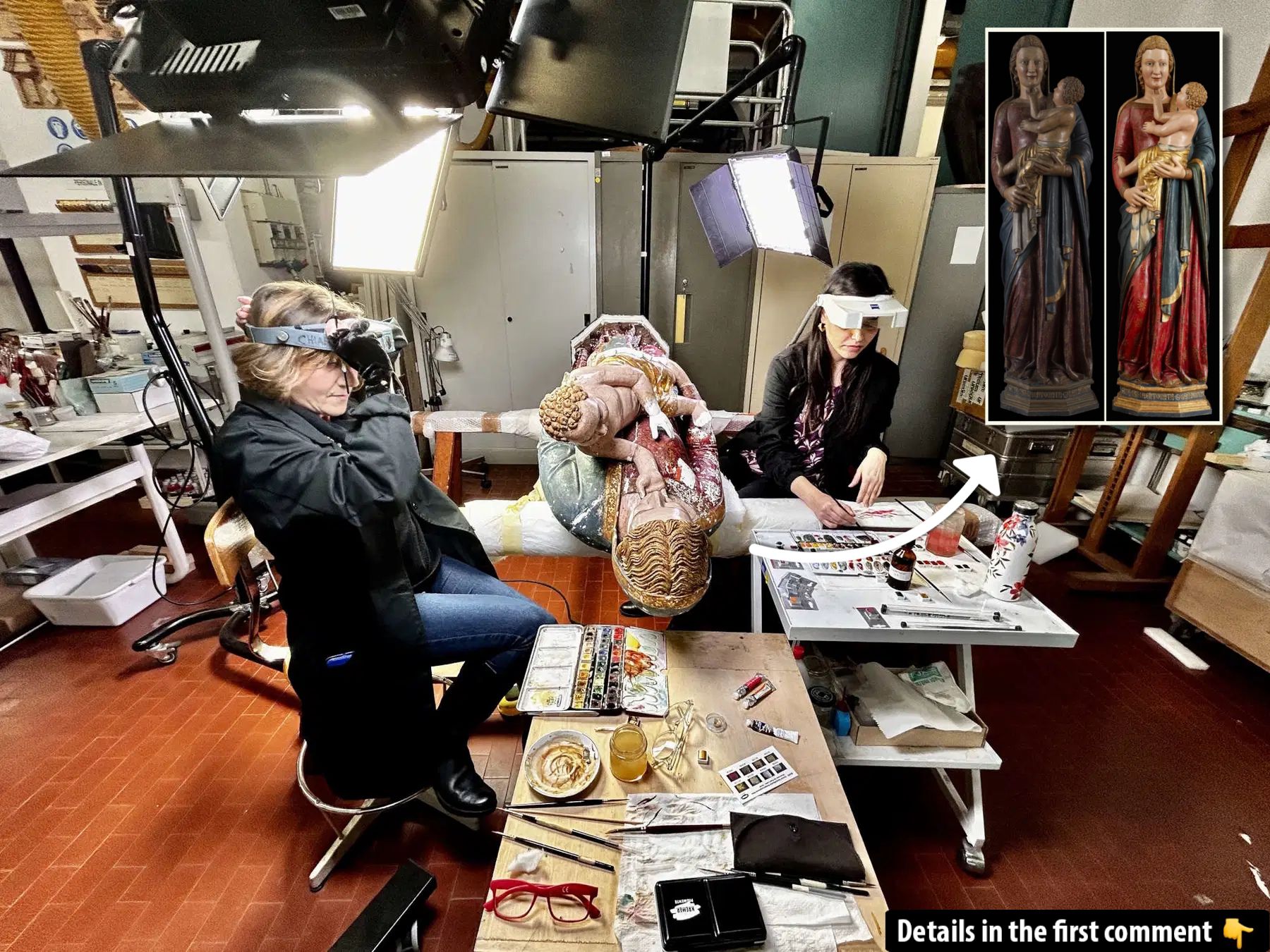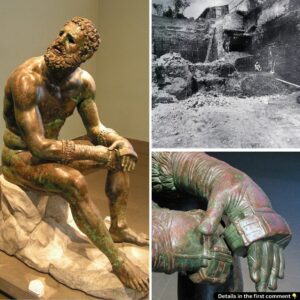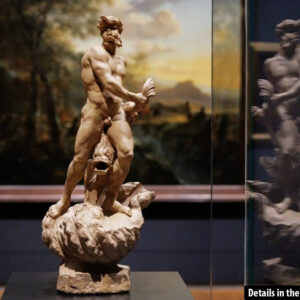In the heart of Florence, a breathtaking restoration has brought a 14th-century masterpiece back to life. The Madonna and Child sculpture, known as the “Bentornata,” has undergone six years of meticulous cleaning and conservation. Once obscured by layers of overpaint and grime, the sculpture’s original vivid polychromy has been restored, allowing it to once again shine in its full glory. This significant restoration not only highlights the artistic mastery of its creator, Giovanni di Francesco Fetti, but also offers us a deeper understanding of the cultural and historical context of the late medieval period.
The Restoration Process: A Labor of Precision
The restoration of the Madonna and Child sculpture was no simple task. Experts at the Opificio delle Pietre Dure (OPD) meticulously analyzed the sculpture to determine the best methods for removing the overpaint and accumulated dirt that had dulled its brilliance over centuries. The sculpture, carved from a single pear tree trunk by Fetti around 1382, was originally painted with deep reds and blues that adorned Mary’s gown, as well as gilded accents that highlighted her blonde hair and the fine details of the figure. However, over the years, the varnishes and repainting, especially those in the 19th century, had darkened and obscured the vibrancy of the pigments.
![Conservationists working meticulously to restore the Madonna and Child sculpture in the lab, ensuring the preservation of its original vibrant colors and intricate details. (Image credit: [Karabük Üniversitesi])](https://historical.vncash24h.com/wp-content/uploads/2025/02/CONSER1.jpg)
![The restored 14th-century Madonna and Child sculpture, showcasing the vibrant colors and intricate details brought back through the restoration process. (Image credit: [Karabük Üniversitesi])](https://historical.vncash24h.com/wp-content/uploads/2025/02/The-restored-14th-century-Madonna-and-Child-sculpture-showcasing-the-vibrant-colors-and-intricate-details-brought-back-through-the-restoration-process-Image-credit-Karabuk-Universitesi-.jpg)
Video
Watch this video to witness the restoration of the Renaissance statue of the Madonna of Childbirth in Rome, bringing this historical artwork back to its former glory.
The Original Artwork: A Masterpiece of the 14th Century
The Madonna and Child sculpture was created by Giovanni di Francesco Fetti, a sculptor renowned for his marble works. Yet this particular piece stands out due to its rarity; carved from wood and enhanced with vibrant polychromy, it is a rare example of Fetti’s mastery in a medium that was less common for him. The sculpture’s vivid color palette, featuring shades of red and blue alongside gilded accents, was intended to bring life and movement to the figures of Mary and Jesus. The deep, rich hues of Mary’s gown were highlighted by gilded edges, while Baby Jesus was wrapped in a shimmering golden robe, with both figures sporting gilded blonde hair.
![Another view of the Madonna and Child statue, now fully restored with vivid polychromy, highlighting the careful conservation efforts made to preserve its historical integrity. (Image credit: [Karabük Üniversitesi])](https://historical.vncash24h.com/wp-content/uploads/2025/02/ANOTHE1.jpg)
The Role of the Basilica of San Lorenzo: A Historical Sanctuary
The sculpture now resides in the Basilica of San Lorenzo, one of the most iconic Renaissance buildings in Florence. Known for its architectural beauty and as the burial place of the Medici family, San Lorenzo is also home to numerous Renaissance masterpieces by renowned artists such as Donatello, Bronzino, and Michelangelo. The Madonna and Child sculpture, however, is one of the few medieval artworks in this remarkable basilica, making it even more exceptional.
The Basilica of San Lorenzo stands as a testament to the genius of Renaissance architecture and art. Its role as a repository of the Medici family’s legacy adds layers of cultural and historical significance to every artifact housed within. The “Bentornata” sculpture, with its unique history and artistic style, is a symbol of the continuity of artistic traditions, bridging the medieval and Renaissance periods.
Conservation and Analysis: Unveiling the Secrets of the Past
The restoration project also offered invaluable insights into the sculpture’s historical and artistic significance. Through the careful analysis of the materials, the restorers were able to learn more about the quality of the craftsmanship and the sophisticated techniques used in its creation. The fine modeling and refinement of the polychromy, combined with the use of precious materials like gold leaf, confirm that the sculpture was a high-value work commissioned by an influential patron.
The restoration also highlighted the materials used in the creation of the piece. The use of pear wood, a durable and fine-grained material, indicates the level of detail and care that went into sculpting the figures. The vivid polychromy, though obscured over time, now stands as a testament to the skill of Fetti and the importance of color in conveying emotion and meaning in medieval art.
![A close-up of the restored Madonna and Child sculpture, with detailed attention to the gilded elements and the rich red and blue tones of Mary’s gown. (Image credit: [Karabük Üniversitesi])](https://historical.vncash24h.com/wp-content/uploads/2025/02/A-close-up-of-the-restored-Madonna-and-Child-sculpture-with-detailed-attention-to-the-gilded-elements-and-the-rich-red-and-blue-tones-of-Marys-gown-Image-credit-Karabuk-Universitesi.jpg)
The Historical and Artistic Value of the Sculpture
The Madonna and Child sculpture is a remarkable example of late medieval craftsmanship and religious devotion. Its rich colors and intricate gilding reveal a deep connection between the material and spiritual worlds, where art was not only a means of expression but also a tool for religious contemplation. The restored sculpture now provides a glimpse into the artistic sensibilities of the late 14th century, showcasing the sophisticated techniques and materials used by artists to create works that resonated with both the mind and the soul.
Fetti’s choice of wood as a medium for this sculpture further emphasizes the uniqueness of the piece. While marble was often the preferred material for artists of the time, the decision to use wood allowed for a different type of expressiveness, one that was both intimate and immediate. The polychromy added to the piece gave it an additional layer of meaning, elevating it beyond a simple devotional object to a work of art that captured the viewer’s attention with its vibrancy and realism.
Video
Check out this video from Short Film Showcase to watch a masterpiece emerge from a solid block of stone, showcasing the artistry and skill of sculptors in action.
Conclusion: A Return to Glory
The restored Madonna and Child sculpture is now back in the Basilica of San Lorenzo, on public display for all to admire. Its return to vivid color allows us to appreciate not only the artistic skill of its creator but also the cultural and religious significance of the time in which it was made. The restoration project, with its careful attention to detail and preservation of the original materials, has ensured that this masterpiece of medieval art will continue to inspire and awe future generations.
The “Bentornata” serves as a reminder of the enduring power of art to connect us to the past, offering a window into the world of medieval Florence and the religious devotion that shaped its artistic heritage. Through the restoration of this remarkable sculpture, we are reminded of the importance of preserving our cultural heritage, ensuring that the beauty and wisdom of the past can continue to enrich our present and future.



